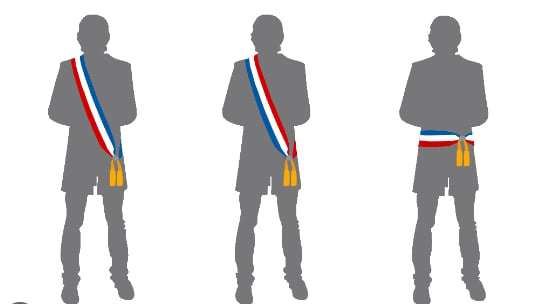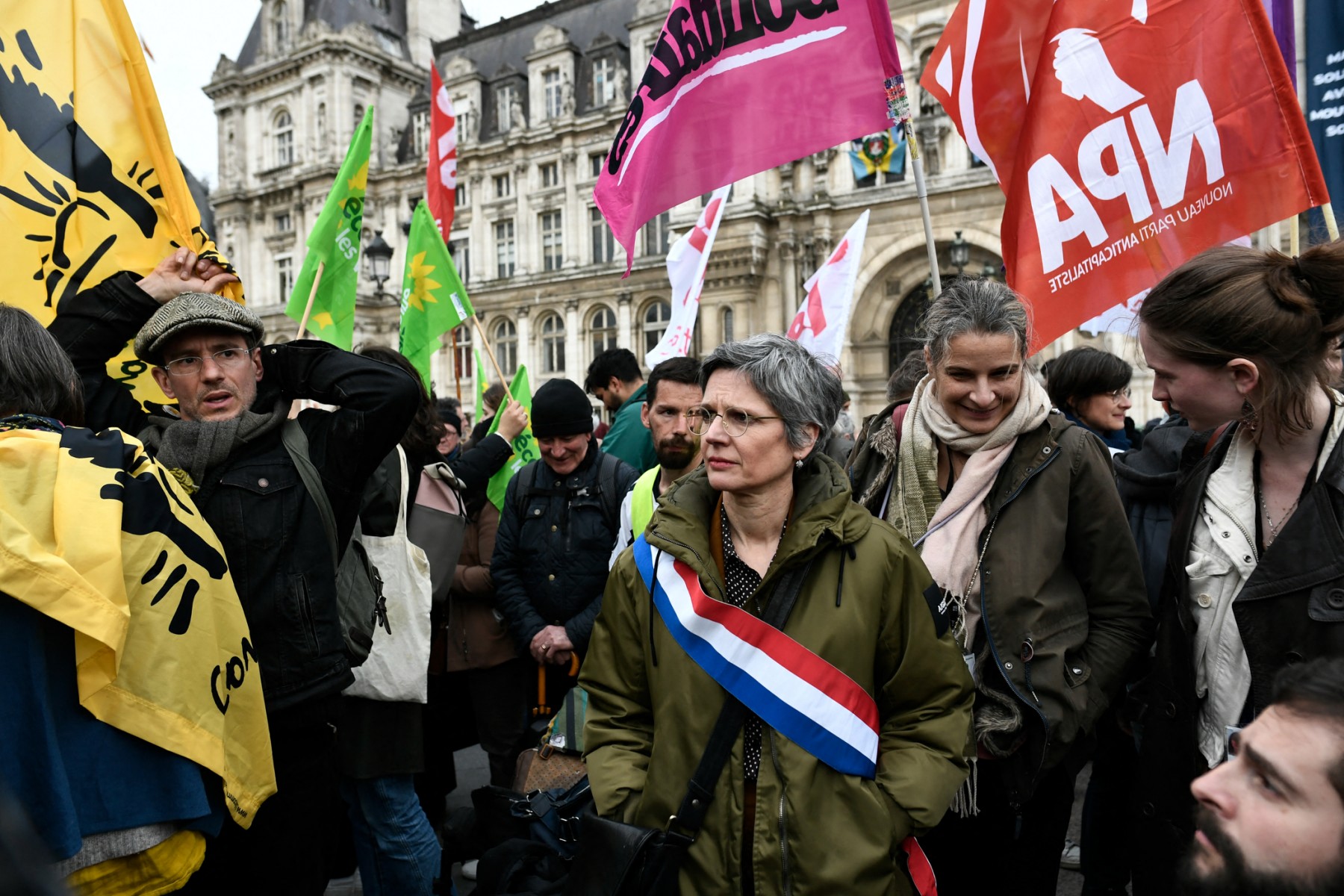How to tell French politicians apart by their sashes

Need to tell at a glance whether you're looking at a French mayor, town councillor, MP or Senator? No problem - all the details you need are in their 'écharpe tricolore'.
If you've spent much time in France you will be aware that politicians wear a sash in the 'tricolore' colours of the French flag on special occasions.
But did you know that how the sash is worn, who else is wearing it and the colour of its fringe will tell you everything you need to know about the person wearing it?
Read on for a deep dive into the wonderful world of 'écharpe etiquette'.
Echarpe tricolore
Une écharpe more usually translates as scarf, and the French have gained something of an international reputation as stylish scarf-wearers.
However une écharpe tricolore is what we might refer to as a sash or even a cummerbund.
It's worn by elected officials - Senators, Députés (members of the lower parliamentary house the Assemblée nationale, equivalent to MPs), mayors, deputy mayors and town council members.
The colours
As the 'tricolore' bit suggests, the sash is in the colours of the French flag - blue, white and red.
However - how the sash is worn gives you your first clue as to the wearer. Députés and Senators wear their sashes with the red at the top - nearest the neck.
However mayors, deputy mayors and town councillors wear theirs with the blue at the top.

Left, the sash as worn by a mayor or deputy mayor, centre the sash as worn by a MP or senator and right, the waist option. Photo: Préfecture du Yonne
The fringe
At the end of the scarf is fringing in either gold or silver - MPs, Senators and mayors get gold, while deputy mayors and councillors have to make do with silver fringe. However, if the deputy mayor is standing in for the mayor at an official function, they are permitted to wear the gold.
Shoulder or waist?
You will most commonly see the écharpe worn as a sash over one shoulder (in French en bandoulière) but it is also permitted to wear it en ceinture - around the waist as a belt.
If wearing it sash style, it must be worn over the right shoulder.
If wearing it around the waist, the same rules apply over whether you wear it with the red at the top, or the blue.
When?
Then there's the question of when the écharpe should be worn, and you may be unsurprised to hear that this is strictly regulated, with the rules for mayors most recently clarified in a decree in the Journal Officiel in 2000.
Local officials wear the sash at public ceremonies and "whenever the performance of their duties may require this distinctive sign of their authority".
This is why mayors always wear their sash when performing a wedding ceremony, because they are acting as an official of the republic.
The sash "reflects the authority of the State conferred on elected representatives by their status as judicial police officers and civil registrars" in legally binding ceremonies such as weddings.
At public events such as commemorations at war memorials, the sash can only be worn by the mayor - or the deputy mayor if they are filling in for the mayor for the occasion.
MPs and Senators do not wear their sashes for ordinary debate sessions in parliament, but do on ceremonial occasions.
You might also see them wearing the sash as a mark of their position if they are taking part in a public event such as a demonstration.

Green party MP Sandrine Rousseau attends a demonstration wearing her sash - with the red at the top. Photo by STEPHANE DE SAKUTIN / AFP
Why?
And finally the big question - why do elected officials still wear this rather archaic piece of clothing?
Well apart from the aesthetic consideration that they look rather nice at special events, the écharpe is the only remaining element of the 'costume des maires' or mayoral outfit that was introduced when the commune system was put into place in 1790 and made compulsory for mayors in a decree of 1852.
The traditional outfit of a mayor is dark trousers, a tailcoat with silver frogging, a sword and a bicorn hat with plumes, plus the sash of course. There is no option for women because French women did not get the right to vote or hold office until 1945, and by then the traditional costume had been phased out.
Le costume des maires français (photo) est fixé par un décret toujours en vigueur mais n'est plus porté que par celui de Plouha. pic.twitter.com/I7hc9h6ZN9
— AnecdotesBot (@AnecdotesBot) August 22, 2020
The outfit is not longer compulsory, but in recent years local mayors including the mayor of La Verrière in Yvelines and the mayor of Plouha in Brittany have decided to revive the traditional outfit for ceremonial occasions such as weddings.
So if your dream is to be married by a man wearing a sword, sash and plumed hat - then head to La Verrière or Plouha. (Or Las Vegas, probably).
Comments (1)
See Also
If you've spent much time in France you will be aware that politicians wear a sash in the 'tricolore' colours of the French flag on special occasions.
But did you know that how the sash is worn, who else is wearing it and the colour of its fringe will tell you everything you need to know about the person wearing it?
Read on for a deep dive into the wonderful world of 'écharpe etiquette'.
Echarpe tricolore
Une écharpe more usually translates as scarf, and the French have gained something of an international reputation as stylish scarf-wearers.
However une écharpe tricolore is what we might refer to as a sash or even a cummerbund.
It's worn by elected officials - Senators, Députés (members of the lower parliamentary house the Assemblée nationale, equivalent to MPs), mayors, deputy mayors and town council members.
The colours
As the 'tricolore' bit suggests, the sash is in the colours of the French flag - blue, white and red.
However - how the sash is worn gives you your first clue as to the wearer. Députés and Senators wear their sashes with the red at the top - nearest the neck.
However mayors, deputy mayors and town councillors wear theirs with the blue at the top.

The fringe
At the end of the scarf is fringing in either gold or silver - MPs, Senators and mayors get gold, while deputy mayors and councillors have to make do with silver fringe. However, if the deputy mayor is standing in for the mayor at an official function, they are permitted to wear the gold.
Shoulder or waist?
You will most commonly see the écharpe worn as a sash over one shoulder (in French en bandoulière) but it is also permitted to wear it en ceinture - around the waist as a belt.
If wearing it sash style, it must be worn over the right shoulder.
If wearing it around the waist, the same rules apply over whether you wear it with the red at the top, or the blue.
When?
Then there's the question of when the écharpe should be worn, and you may be unsurprised to hear that this is strictly regulated, with the rules for mayors most recently clarified in a decree in the Journal Officiel in 2000.
Local officials wear the sash at public ceremonies and "whenever the performance of their duties may require this distinctive sign of their authority".
This is why mayors always wear their sash when performing a wedding ceremony, because they are acting as an official of the republic.
The sash "reflects the authority of the State conferred on elected representatives by their status as judicial police officers and civil registrars" in legally binding ceremonies such as weddings.
At public events such as commemorations at war memorials, the sash can only be worn by the mayor - or the deputy mayor if they are filling in for the mayor for the occasion.
MPs and Senators do not wear their sashes for ordinary debate sessions in parliament, but do on ceremonial occasions.
You might also see them wearing the sash as a mark of their position if they are taking part in a public event such as a demonstration.

Why?
And finally the big question - why do elected officials still wear this rather archaic piece of clothing?
Well apart from the aesthetic consideration that they look rather nice at special events, the écharpe is the only remaining element of the 'costume des maires' or mayoral outfit that was introduced when the commune system was put into place in 1790 and made compulsory for mayors in a decree of 1852.
The traditional outfit of a mayor is dark trousers, a tailcoat with silver frogging, a sword and a bicorn hat with plumes, plus the sash of course. There is no option for women because French women did not get the right to vote or hold office until 1945, and by then the traditional costume had been phased out.
Le costume des maires français (photo) est fixé par un décret toujours en vigueur mais n'est plus porté que par celui de Plouha. pic.twitter.com/I7hc9h6ZN9
— AnecdotesBot (@AnecdotesBot) August 22, 2020
The outfit is not longer compulsory, but in recent years local mayors including the mayor of La Verrière in Yvelines and the mayor of Plouha in Brittany have decided to revive the traditional outfit for ceremonial occasions such as weddings.
So if your dream is to be married by a man wearing a sword, sash and plumed hat - then head to La Verrière or Plouha. (Or Las Vegas, probably).
Join the conversation in our comments section below. Share your own views and experience and if you have a question or suggestion for our journalists then email us at [email protected].
Please keep comments civil, constructive and on topic – and make sure to read our terms of use before getting involved.
Please log in here to leave a comment.